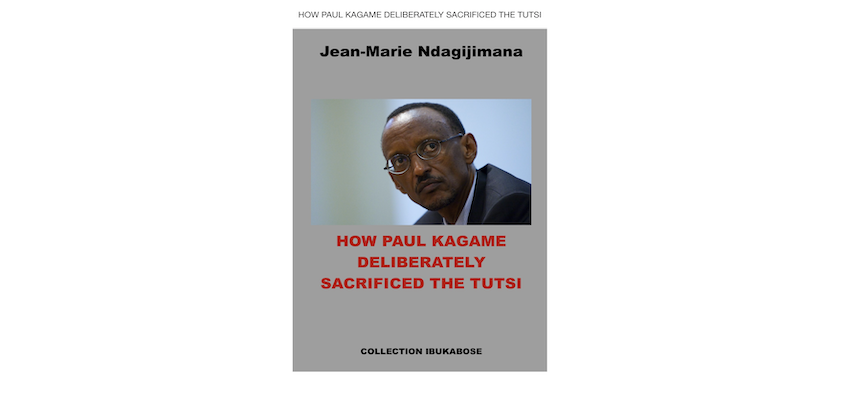How Paul Kagame Deliberately Sacrificed the Tutsi
TRANSCEND MEMBERS, 25 Mar 2024
Ann Garrison | Black Agenda Report – TRANSCEND Media Service
20 Mar 2024 – 2024 marks the 30th anniversary of the Rwandan Genocide. Review of “How Paul Kagame Sacrificed the Tutsi,” one of many important books that challenge the prevailing narrative about the events of 1994.
On October 1, 1990, Ugandan troops invaded Rwanda from Uganda. They wore Ugandan uniforms, drove Ugandan vehicles, and carried weapons from the Ugandan arsenal. They were led by top ranking officers in the Ugandan military who had family roots in Rwanda and called themselves the Rwandan Patriotic Front (RPF). Led by then General, now President Paul Kagame, they were determined to seize power in Rwanda and re-establish the ethno-supremacist Tutsi rule that had ended with the Hutu Power Revolution of 1959. They succeeded after waging a four-year war, with the help of the US, and though Rwanda pretends to have ended ethnic division and exclusion, a Wikileaks diplomatic cable reveals that all top government positions are in fact held by Tutsi and Rwanda reconciliation is a lie. Only Tutsi are allowed to publicly mourn their family members who died in the 90-day massacres of 1994, and the description “genocide against the Tutsi” is legally codified and enforced. Anyone using any other description faces prison time in Rwanda.
The invasion violated international law and Rwanda’s sovereignty, but the world barely noticed. The UN Security Council declined to even discuss it, despite the request of Rwanda’s Ambassador to the UN. Ugandan President Yoweri Museveni had just become President of the Organization of African Unity (OAU)—which later became the African Union—and as such he assumed the role of “mediator” even though he was the principal aggressor and of course had no interest in upholding international law.
 In “How Paul Kagame Deliberately Sacrificed the Tutsi, ” former Rwandan Ambassador to Paris Jean-Marie Ndagijimana writes, “Two months earlier, on 2 August, 1990, Iraq under Saddam Hussein invaded its little neighbor Kuwait, and the international community went to work to put out the oil pipeline fires in what is the world’s premier oil reserve. So we poor Negroes could kill one another in silence without bothering the masters of the world who were busy elsewhere.”
In “How Paul Kagame Deliberately Sacrificed the Tutsi, ” former Rwandan Ambassador to Paris Jean-Marie Ndagijimana writes, “Two months earlier, on 2 August, 1990, Iraq under Saddam Hussein invaded its little neighbor Kuwait, and the international community went to work to put out the oil pipeline fires in what is the world’s premier oil reserve. So we poor Negroes could kill one another in silence without bothering the masters of the world who were busy elsewhere.”
The ensuing four-year war included the RPF’s horrific massacres, including targeted massacres of Hutus, but it was still barely noticed by the international community until it finally concluded in the 90-day bloodbath that included both Tutsi and Hutu genocides. Only the Tutsi genocide was broadcast around the world and later depicted in the Hollywood movie “Hotel Rwanda.”
Millions of people saw “Hotel Rwanda,” and the Rwandan Genocide thus came to be understood ahistorically, as a sudden 90-day episode of mass psychosis and bloodlust in which the Hutu majority attempted to exterminate the Tutsi minority. Hutu people have been demonized not only in Rwanda but around the world ever since. For thirty years, Rwandan President Paul Kagame has been allowed to wage a devastating war in the Democratic Republic of the Congo on the grounds that he is hunting Hutus who were guilty of the genocide against the Tutsi and who still threaten Rwanda.
“Stopping the next Rwanda” became the battle cry of the humanitarian warriors led by Samantha Power, who built her career on “Bystanders to Genocide, ” her crusading critique of the Clinton administration for failing to stop the genocide. She insisted that we must all from hereon be “upstanders,” not bystanders to genocide, most notably in Libya and Syria, but she hasn’t called for any upstanding to stop genocide in Gaza.
“How Paul Kagame Deliberately Sacrificed the Tutsi” is one of many important books that tell the far more complex story of both Hutu and Tutsi genocides that took place over four years in Rwanda and years after that in the Democratic Republic of the Congo.
It was a Ugandan invasion he writes, but it “was gradually transformed into a civil war by the desire for appeasement between the parties.” In other words, the Rwandan government led by President Juvenal Habyarimana accepted that the Ugandan troops with Rwandan roots were Rwandans and entered into negotiations with them, which produced the Arusha Accords signed in Arusha, Tanzania, on August 4, 1993, by the Rwandan government and the RPF.
The Arusha Accords laid out a timetable that would lead to the multi-party elections that the international community had insisted on. However, Paul Kagame and the RPF, as a minority Tutsi party, could not have won those elections, so he had to find an excuse to seize power by force of arms with the support of the US. That excuse was, Ndagijimana argues, the genocide of the Tutsi who remained in Rwanda after the Hutu Revolution of 1959.
Ndagijimana cites the abundant evidence that Kagame ordered the assassination of President Habyarimana, which triggered panic and the horrifying Tutsi massacres broadcast internationally. “It must be noted, however,” he writes, “that the involvement of Paul Kagame does nothing to excuse the perpetrators of the Tutsi genocide, even if it does explain the Machiavellian cynicism of this former chief of military intelligence for the Ugandan army.”
As soon as the president was assassinated, the RPF broke the ceasefire, launching a push to seize power while claiming that they were fighting to save the Tutsi. The government and its army made repeated pleas to stop the war so that they could stop the Tutsi genocide, but Kagame and the RPF absolutely refused and even blocked a plan for UN intervention because they were determined to see the RPF and Kagame seize power. “The RPF and the American government did everything they could to make sure our parents would not be saved from these massacres,” Ndagijimana writes. “They stacked ‘one obstacle on another’ to keep the UN from sending international troops to stop the genocide, with their sole purpose being to allow Kagame to ‘ascend to power.’”
Ndagijimana is of both Hutu and Tutsi parentage. Why, he asks, shouldn’t he be allowed to mourn both, and why shouldn’t both receive justice? He says, as many others have, that the unequal, victor’s justice meted out by the International Criminal Tribunal on Rwanda and the repression of memory and mourning create dangerous ethnic tension simmering below Rwanda’s facade of ethnic reconciliation.
“I already know,” he writes, “what to expect from writing this book: to be held up to public obloquy as a negationist and revisionist. It is a sort of existential challenge when you consider the fate that generally awaits confirmed negationists and revisionists. I accept this challenge because there is no price on the Truth. I crossed the Rubicon without trepidation. I have been a political exile far from my home since 1994. I felt welcome in France because it represented an alternative to the atmosphere of terror that pervaded my country. If I had to continue living in fear of expressing myself in this country I consider my second home, I don’t know what I would be doing in France.”
Jean-Marie Ndagijimana is far from the only one to publish the same, similar, and related conclusions with various areas of emphasis and investigation. This is an incomplete list:
Rwanda and the New Scramble for Africa, from Tragedy to Useful Imperial Fiction , by Robin Philpot
Enduring Lies: The Rwandan Genocide in the Propaganda System, 20 Years Later , by Edward S. Herman and David Peterson
In Praise of Blood: Crimes of the Rwandan Patriotic Front , by Judi Rever
The Accidental Genocide , by Peter Erlinder
Surviving the Slaughter: The Ordeal of a Rwandan Refugee in Zaire , by Marie Beatrice Umutesi
Dying to Live: A Rwandan Family’s Five Year Flight Across the Congo , by Pierre-Claver Ndacyayisenga
America’s Wars on Democracy in Rwanda and the DRC , by Justin Podhur
Post-Genocide Rwandan Refugees: Why They Refuse to Return ‘Home’: Myths and Realities , by Masako Yonekawa
Rwanda 1994: The Myth of the Akazu Genocide Conspiracy and Its Consequences , by Barrie Collins
The 1994 [UN] Gersony Report
The 1998 [UN] Garreton Report
The UN Group of Experts Reports on the Democratic Republic of the Congo , 2001-2020
The UN Mapping Report on Human Rights Abuse in the Democratic Republic of the Congo, 1993 to 2003
_______________________________________________
 Ann Garrison is an independent journalist based in the San Francisco Bay Area. She attended Stanford University and is a member of the TRANSCEND Network for Peace Development Environment. In 2014 she received the Victoire Ingabire Umuhoza Democracy and Peace Prize for her reporting on conflict in the African Great Lakes region. She can be reached at @AnnGarrison, ann@anngarrison.com.
Ann Garrison is an independent journalist based in the San Francisco Bay Area. She attended Stanford University and is a member of the TRANSCEND Network for Peace Development Environment. In 2014 she received the Victoire Ingabire Umuhoza Democracy and Peace Prize for her reporting on conflict in the African Great Lakes region. She can be reached at @AnnGarrison, ann@anngarrison.com.
Go to Original – blackagendareport.com
Tags: Africa, Genocide, Paul Kagame, Rwanda, Tutsis
DISCLAIMER: The statements, views and opinions expressed in pieces republished here are solely those of the authors and do not necessarily represent those of TMS. In accordance with title 17 U.S.C. section 107, this material is distributed without profit to those who have expressed a prior interest in receiving the included information for research and educational purposes. TMS has no affiliation whatsoever with the originator of this article nor is TMS endorsed or sponsored by the originator. “GO TO ORIGINAL” links are provided as a convenience to our readers and allow for verification of authenticity. However, as originating pages are often updated by their originating host sites, the versions posted may not match the versions our readers view when clicking the “GO TO ORIGINAL” links. This site contains copyrighted material the use of which has not always been specifically authorized by the copyright owner. We are making such material available in our efforts to advance understanding of environmental, political, human rights, economic, democracy, scientific, and social justice issues, etc. We believe this constitutes a ‘fair use’ of any such copyrighted material as provided for in section 107 of the US Copyright Law. In accordance with Title 17 U.S.C. Section 107, the material on this site is distributed without profit to those who have expressed a prior interest in receiving the included information for research and educational purposes. For more information go to: http://www.law.cornell.edu/uscode/17/107.shtml. If you wish to use copyrighted material from this site for purposes of your own that go beyond ‘fair use’, you must obtain permission from the copyright owner.